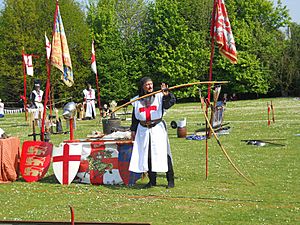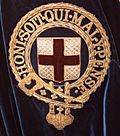Saint George's Day in England facts for kids
Quick facts for kids Saint George's Day in England |
|
|---|---|
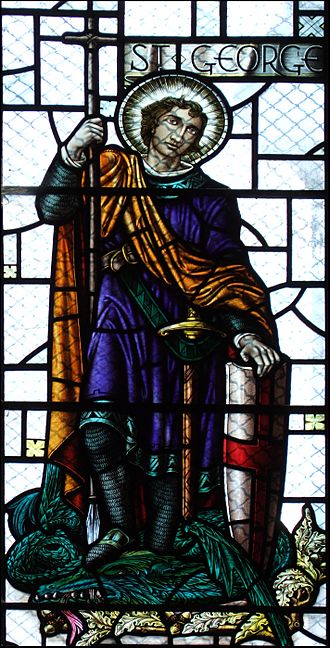
Saint George shown in a stained glass window in the St Mary the Virgin's Church, South Darley, Derbyshire.
|
|
| Observed by | 23 countries around the world English people, Church of England, Catholic Church in England and Wales |
| Significance | Feast day of Saint George as national saint of England |
| Celebrations | Church services, celebration of English culture |
| Date | 23 April |
| Next time | 23 April 2026 |
| Frequency | annual |
| Related to | St George's Day in other countries |
Saint George is known as the patron saint of England. This tradition started a long time ago, during the Tudor period. People really liked Saint George during the Crusades (holy wars) and the Hundred Years' War (a long conflict between England and France).
Over time, people celebrated Saint George less. But in 1894, a group called the Royal Society of St. George was formed. They wanted to bring back the celebration of Saint George's Day (April 23rd) to show pride in English culture and identity. Since the early 2010s, these efforts have made Saint George's Day feel more like a national holiday in England.
Contents
When is Saint George's Day?
Religious groups like the Church of England and the Catholic Church in England and Wales celebrate Saint George's Day. However, the date can change if it falls too close to Easter.
For example, if April 23rd is during the week before or after Easter, the celebration is moved. In 2011, it was moved to May 2nd. In 2014, it was moved to April 28th. This ensures the holiday doesn't clash with important Easter events.
History of Saint George's Day
Early Mentions of Saint George
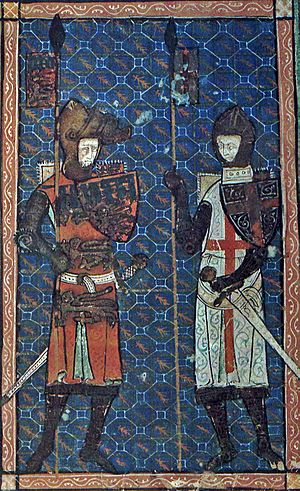
The first time Saint George was mentioned in England was by a writer called Venerable Bede in the early 700s. His special day was also noted in a church book from the 800s. Even Alfred the Great, a famous English king, might have mentioned Saint George in his will.
Some of the oldest churches in England, built around the 900s, were named after Saint George. These include churches in places like Fordington, Thetford, Southwark, and Doncaster.
Saint George as a Warrior Saint
Saint George became very popular as a warrior saint during the Crusades. These were military journeys to the Holy Land. However, he wasn't officially the patron saint of England during the High Middle Ages. At that time, Saints Edward the Confessor and Edmund the Martyr were more closely linked to England.
In 1348, King Edward III gave Saint George a special role. He made him the patron saint of the Order of the Garter. This was a special group of knights, and the king did this to thank Saint George for supposedly helping him win the Battle of Crécy.
From then on, Saint George's flag was used more and more alongside the king's own flag. It became a regular part of the Royal Standard.
St George's Chapel at Windsor Castle was built in honor of the Order of the Garter. The badge of the Order shows Saint George riding a horse and fighting a dragon. During the Hundred Years' War (1337–1453), English soldiers often shouted "Saint George!" as a battle cry. Some English soldiers even carried Saint George's flag.
For a long time, Saint George's Day was just one of many saint's days. It wasn't until the late Middle Ages that it became more important. In 1415 and 1421, church leaders made Saint George's Day a "double major feast." But even then, other saints like Edward and Edmund were still very important.
Tudor Period and Beyond
During the English Reformation, when many religious changes happened, Saint George's position as England's patron saint remained strong. His flag was one of the few religious flags that were not removed.
The St. George's Cross flag was first used by English ships in 1545. Later, in 1606, it was combined with the Scottish St. Andrew's Cross to create the Union Jack, which is the flag of the United Kingdom.
In his famous play Henry V, William Shakespeare wrote a well-known line. Before the Battle of Agincourt in 1415, King Henry V tells his soldiers to shout: "God for Harry, England, and Saint George!" Many people at Agincourt believed they saw Saint George fighting on the English side.
The Cross of St. George was flown by explorers like John Cabot in 1497 when he discovered Newfoundland. It was also used by Sir Francis Drake and Sir Walter Raleigh. In 1620, the Pilgrim Fathers flew this flag on their ship, the Mayflower, when they arrived in Plymouth, Massachusetts.
Modern History and Celebrations
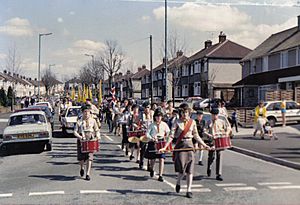
In the early 1600s, there were traditional plays called Pace Egg plays that featured Saint George as a hero. However, by the late 1700s, after England and Scotland joined together, the tradition of celebrating Saint George's Day had faded.
The Royal Society of St. George was started in 1894. Its goal was to promote English culture, including Saint George's Day.
A traditional custom on Saint George's Day is to wear a red rose on your jacket. However, this is not as common today.
Saint George was chosen by Robert Baden-Powell, the founder of the Scout movement, as the patron saint of Scouts. British scouting groups still celebrate Saint George's Day. Many Scout districts hold events like parades and religious services on the Sunday closest to April 23rd.
Bringing Back the Celebrations
Since the mid-1990s, there has been a growing interest in Saint George as England's patron saint. For example, the Flag of England (the Saint George's Cross) used to be mainly seen with political groups. But during the 1996 European Championships held in England, football fans started waving it to support their country. Now, the flag is often seen at sporting events and flown by churches and local councils.
At the same time, groups like English Heritage and the Royal Society of Saint George have encouraged Saint George's Day to become a national holiday. This partly happened because some people wanted to replace Saint George as England's patron saint. A 2003 poll by BBC Radio 4 showed some interest in changing him.
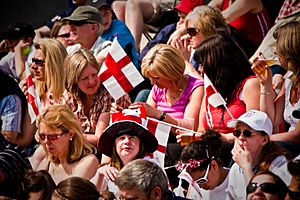
In 2002, a group protested in London because the Mayor, Ken Livingstone, wasn't supporting Saint George's Day. He had plans to spend a lot of money on St Patrick's Day instead. The group decided to dye the fountains red in Trafalgar Square for Saint George's Day.
From this, supporters started a private Saint George's Feast in London in 2003. This festival grew bigger each year. It included traditional shows like Punch and Judy, English folk dances, Morris dancers, and English folk music. The Royal Society of St George joined in the 2006 event, which was even covered by BBC Radio 3.
In 2009, the new Mayor of London, Boris Johnson, started a campaign to encourage public celebrations. The first official "Pageant of St George" in 425 years was held in 2010. This event has now become a big festival in Trafalgar Square, organized by the Mayor of London.
In 2011, a campaign started online to make Saint George's Day a public holiday in England. It got over 4,000 signatures, but not enough to be discussed in the House of Commons.
In 2014, a Member of Parliament, Andrew Rosindell, argued that Saint George's Day should be an official public holiday. The Labour Leader Jeremy Corbyn also promised to make Saint George's Day one of four new public holidays if his party won the 2017 election.
Other Anniversaries on April 23rd

April 23rd is also a special day because it's believed to be the birthday and death day of the famous writer William Shakespeare. He was baptized on April 26, 1564, and died on April 23, 1616. Many people celebrate his birthday on this day in his hometown of Stratford upon Avon and around the world.
Other important events on April 23rd include:
- English history
- 725: Death of Wihtred, King of Kent.
- 871: Death of King Ethelred of Wessex and the start of Alfred the Great's rule.
- 1016: Death of Ethelred II of England and the start of Edmund Ironside's rule.
- 1348: The Order of the Garter, a very old English group of knights, was founded. Its badge is the flag of Saint George.
- 1661: King Charles II of England was crowned.
- 1924: The first radio broadcast by an English king, King George V.
- 1942: During World War II, German bombers attacked English cities like Exeter, Bath, and York.
- Arts and Literature
- 1775: Birth of the artist J. M. W. Turner.
- 1850: Death of the poet William Wordsworth.
- 1915: Death of the poet Rupert Brooke.
- Sports
- 1986: Death of cricketer Jim Laker.
- 1997: Death of cricketer Denis Compton.
See also
- Oak Apple Day
- Trafalgar Day
- Saint Crispin's Day
- Feast day of St Thomas Becket
- May Day in England
- Minden Day


